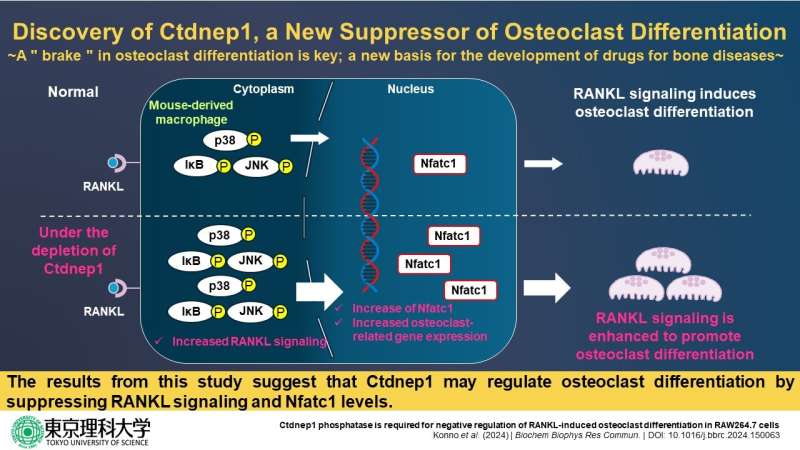This article has been reviewed according to Science X's editorial process and policies. Editors have highlighted the following attributes while ensuring the content's credibility:
fact-checked
peer-reviewed publication
trusted source
proofread
New study reveals key protein that could help prevent excessive bone loss in osteoporosis

Osteoporosis, a condition characterized by porous and fragile bones, poses a significant threat to skeletal health. As the very framework of the human body, bones provide crucial structural support. When bone mass diminishes, it not only compromises this support but also impairs overall function, leading to a diminished quality of life.
With the aging population experiencing a surge in osteoporosis cases, the strain on health care resources for long-term care is evident. Hence, there is a need to understand the mechanisms that contribute to osteoporosis and develop effective targeted therapies to minimize its long-term impact.
Osteoblasts and osteoclasts are two types of cells crucial for the maintenance and remodeling of bone tissue. While osteoblasts are the bone-forming cells responsible for synthesizing and depositing new bone tissue, osteoclasts are the bone-resorbing cells involved in the breakdown and removal of old or damaged bone tissue.
An increase in the proportion of osteoclasts leads to loss of bone mass in conditions like osteoporosis, rheumatoid arthritis (joint inflammation), and bone metastases (cancer that has spread to the bones). Osteoclasts arise from the differentiation of macrophages or monocytes, which are types of immune cells.
Suppressing osteoclast differentiation can, therefore, serve as a therapeutic strategy to prevent bone loss. However, the precise molecular mechanisms governing the complex process of bone remodeling remain unclear.
In a new study, Professor Tadayoshi Hayata, Mr. Takuto Konno, and Ms. Hitomi Murachi from Tokyo University of Science, along with their co-workers, delved deeper into the molecular regulation of osteoclast differentiation. Receptor activator of nuclear factor kappa B ligand (RANKL) stimulation induces the differentiation of macrophages into osteoclasts.
In addition, bone morphogenetic protein (BMP) and transforming growth factor (TGF)-β signaling pathways have been implicated in the regulation of RANKL-mediated osteoclast differentiation. In the current study, the researchers sought to investigate the role of Ctdnep1—a phosphatase (an enzyme that removes phosphate groups) that has been reported to suppress BMP and TGF-β signaling.
The research is published in the journal Biochemical and Biophysical Research Communications.
Prof. Hayata states, "RANKL functions as an 'accelerator' for osteoclast cell differentiation. Driving a car requires not only the accelerator but also the brakes. Here, we find that Ctdnep1 functions as a 'brake' on osteoclast cell differentiation."
First, the researchers examined the expression of Ctdnep1 in mouse-derived macrophages treated with RANKL and untreated control cells. They noted that Ctdnep1 expression remained unchanged in response to RANKL stimulation. However, it localized in the cytoplasm in granular form in the macrophages and differentiated into osteoclasts, distinct from its normal peri-nuclear localization in other cell types, indicating its cytoplasmic function in osteoclast differentiation.
In addition, Ctdnep1 knockdown (downregulation of gene expression) resulted in an increase in tartrate-resistant acid phosphatase-positive (TRAP) osteoclasts; wherein TRAP is a marker for differentiated osteoclasts.
Ctdnep1 knockdown led to an increase in the expression of crucial differentiation markers including "Nfatc1," a RANKL-induced master transcription factor for osteoclast differentiation. These results support the "brake function" of Ctdnep1, whereby, it negatively regulates osteoclast differentiation. Moreover, Ctdnep1 knockdown also led to increased absorption of calcium phosphate, suggestive of the suppressive role of Ctdnep1 in bone resorption.
Lastly, while, Ctdnep1 knockdown did not alter BMP and TGF-β signaling, cells deficient in Ctdnep1 showed elevated levels of phosphorylated (activated) proteins downstream of the RANKL signaling pathway. These findings suggest that the suppressive effect of Ctdnep1 in osteoclast differentiation may not be mediated by BMP and TGF-β signaling, but, through the negative regulation of RANKL signaling and Nfatc1 protein levels.
Overall, these findings provide novel insights into the process of osteoclast differentiation and reveal potential therapeutic targets which can be pursued to develop treatments that address bone loss due to excessive osteoclast activity. In addition to diseases characterized by bone loss, Ctdnep1 has also been reported as a causative factor in medulloblastoma—a childhood brain tumor. The authors are, therefore, optimistic that their research can be extended to other human diseases beyond bone metabolism.
Prof. Hayata concludes, "Our findings suggest that Ctdnep1 is necessary to prevent excessive osteoclastogenesis. These results can further expand the knowledge on how the phosphorylation-dephosphorylation network controls osteoclast differentiation, and may provide new therapeutic strategies for bone diseases related to excessive osteoclast cell activity."
More information: Takuto Konno et al, Ctdnep1 phosphatase is required for negative regulation of RANKL-induced osteoclast differentiation in RAW264.7 cells, Biochemical and Biophysical Research Communications (2024). DOI: 10.1016/j.bbrc.2024.150063

















